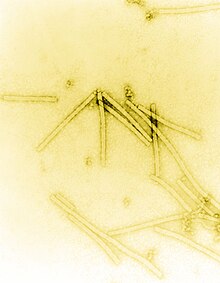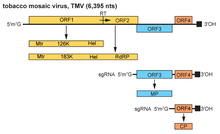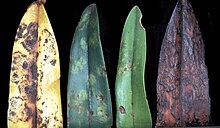Tobacco mosaic virus
| Tobacco mosaic virus | |
|---|---|

| |
Transmission electron micrograph of TMV particles negative stained to enhance visibility at 160,000× magnification
| |
| Virus classification | |
| (unranked): | Virus |
| Realm: | Riboviria |
| Kingdom: | Orthornavirae |
| Phylum: | Kitrinoviricota |
| Class: | Alsuviricetes |
| Order: | Martellivirales |
| Family: | Virgaviridae |
| Genus: | Tobamovirus |
| Species: | Tobacco mosaic virus
|
Tobacco mosaic virus (TMV) is a
History
In 1886,
Structure
Genome

The TMV genome consists of a 6.3–6.5 kbp single-stranded (ss)
Physicochemical properties
TMV is a
TMV has an
Disease cycle
TMV does not have a distinct overwintering structure. Rather, it will over-winter in infected tobacco stalks and leaves in the soil, on the surface of contaminated seed (TMV can even survive in contaminated tobacco products for many years, so smokers can accidentally transmit it by touch, although not in the smoke itself).[26][27] With the direct contact with host plants through its vectors (normally insects such as aphids and leafhoppers), TMV will go through the infection process and then the replication process.
Infection and transmission
After its multiplication, it enters the neighboring cells through
It can also spread through phloem for longer distance movement within the plant. Moreover, TMV can be transmitted from one plant to another by direct contact. Although TMV does not have defined transmission vectors, the virus can be easily transmitted from the infected hosts to the healthy plants by human handling.
Replication
Following entry into its host via mechanical inoculation, TMV uncoats itself to release its viral [+]RNA strand. As uncoating occurs, the MetHel:Pol gene is translated to make the capping enzyme MetHel and the RNA Polymerase. Then the viral genome will further replicate to produce multiple mRNAs via a [-]RNA intermediate primed by the tRNAHIS at the [+]RNA 3' end. The resulting mRNAs encode several proteins, including the coat protein and an RNA-dependent RNA polymerase (RdRp), as well as the movement protein. Thus TMV can replicate its own genome.
After the coat protein and RNA genome of TMV have been synthesized, they spontaneously assemble into complete TMV virions in a highly organized process. The protomers come together to form disks or
Host and symptoms


Like other plant pathogenic viruses, TMV has a very wide host range and has different effects depending on the host being infected. Tobacco mosaic virus has been known to cause a production loss for flue cured tobacco of up to two percent in
Environment
TMV is one of the most stable viruses and has a wide survival range. As long as the surrounding temperature remains below approximately 40 degrees Celsius, TMV can sustain its stable form. All it needs is a host to infect. If necessary, greenhouses and botanical gardens would provide the most favorable condition for TMV to spread out, due to the high population density of possible hosts and the constant temperature throughout the year. It also could be useful to culture TMV in vitro in sap because it can survive up to 3000 days.[34]
Treatment and management
One of the common control methods for TMV is sanitation, which includes removing infected plants and washing hands in between each planting. Crop rotation should also be employed to avoid infected soil/seed beds for at least two years. As for any plant disease, looking for resistant strains against TMV may also be advised. Furthermore, the cross protection method can be administered, where the stronger strain of TMV infection is inhibited by infecting the host plant with a mild strain of TMV, similar to the effect of a vaccine.
In the past ten years, the application of genetic engineering on a host plant genome has been developed to allow the host plant to produce the TMV coat protein within their cells. It was hypothesized that the TMV genome will be re-coated rapidly upon entering the host cell, thus it prevents the initiation of TMV replication. Later it was found that the mechanism that protects the host from viral genome insertion is through gene silencing.[35]
TMV is inhibited by a product of the
Research has shown that Bacillus spp. can be used to reduce the severity of symptoms from TMV in tobacco plants. In the study, treated tobacco plants had more growth and less build-up of TMV virions than tobacco plants that hadn't been treated.[36]
A research has been conducted by H.Fraenkel-Conrat to show the influence of acetic acid on the Tobacco Mosaic Virus. According to the research, 67% acetic acid resulted as degradation of the virus.[37]
Another possible source of prevention for TMV is the use of salicylic acid. A study completed by a research team at the University of Cambridge found that treating plants with salicylic acid reduced the amount of TMV viral RNAs and viral coat protein present in the tobacco plants. Their research showed that salicylic acid most likely was disrupting replication and transcription and more specifically, the RdRp complex.[38]
A research was conducted and revealed that humans have antibodies against Tobacco Mosaic Virus.[39]
Scientific and environmental impact
Applications
Plant viruses can be used to engineer
References
- ^ "The Largest Molecule Ever Made Could Be Used to Deliver Drugs". Popular Science. 2019-03-18. Retrieved 2021-05-09.
- ^ Mayer A (1886). "Über die Mosaikkrankheit des Tabaks". Die Landwirtschaftliche Versuchs-stationen (in German). 32: 451–467. Translated into English in Johnson J, ed. (1942). "Concerning the mosaic disease of tobacco" (PDF). Phytopathological Classics. 7. St. Paul, Minnesota: American Phytopathological Society: 11–24.
- ^ ISBN 978-981-02-1313-8.
- ^ Iwanowski D (1892). "Über die Mosaikkrankheit der Tabakspflanze". Bulletin Scientifique Publié Par l'Académie Impériale des Sciences de Saint-Pétersbourg / Nouvelle Serie III (in German and Russian). 35: 67–70. Translated into English in Johnson J, ed. (1942). "Concerning the mosaic disease of the tobacco plant". Phytopathological Classics. 7. St. Paul, Minnesota: American Phytopathological Society: 27–30.
- JSTOR 43221892.
- ^ Beijerinck MW (1898). "Über ein Contagium vivum fluidum als Ursache der Fleckenkrankheit der Tabaksblätter" (PDF). Verhandelingen der Koninklijke Akademie van Wetenschappen te Amsterdam (in German). 65: 1–22. Translated into English in Johnson J, ed. (1942). "Contagium vivum fluidum as the cause of spot disease in tobacco leaves". Phytopathological Classics. 7. St. Paul, Minnesota: American Phytopathological Society: 33–52.
- ^ "Wendell M. Stanley – Biographical". nobelprize.org.
- ^ "The Nobel Prize in Chemistry 1946". NobelPrize.org. Retrieved 2019-12-03.
- S2CID 37003363.
- S2CID 206795712.
- ISBN 978-0-06-018407-0.
- ^ Zaitlin M (1984). Brunt AA, Crabtree K, Dallwitz MJ, Gibbs AJ, Watson L, Zurcher EJ (eds.). "Tobacco mosaic tobamovirus". Plant Viruses Online: Descriptions and Lists from the VIDE Database. Archived from the original on 2009-10-01.
- PMID 14151998.
- ISBN 978-0-7167-1843-7.
- PMID 10212932.
- PMID 3952490.
- PMID 6964389.
- EMBL- EBI. Retrieved 28 March 2020.
International central site for archiving nucleic acid sequence. The reference standard in international science.
- PMID 10212932.
- PMID 10212933.
- ^ "Tobamovirus". Expasy Viralzone. SIB Swiss Institute of Bioinformatics.
- .
- ^ PMID 6964389.
- ^ Islam W, Qasim M, Ali N, Tayyab M, Chen S, Wang L (Jan 16, 2018). "Management of Tobacco Mosaic Virus through Natural Metabolites" (PDF). Records of Natural Products: 404.
- PMID 3547653.
- ^ "Is smoking harmful to plants?". OSU Extension Service. Ohio State University. 2018-05-02. Retrieved 2021-03-06.
- ^ "Tobacco Mosaic Virus (TMV)". Penn State Extension. Penn State College of Agricultural Sciences. Retrieved 2021-03-06.
- ^ a b "Tobacco Mosaic Virus: Pioneering Research for a Century". academic.oup.com. Retrieved 2022-10-09.
- ISBN 978-0-07-110231-5.
- ^ Melton TA (2001). "Control of Tobacco Mosaic Virus on Flue-Cured Tobacco". North Carolina Cooperative Extension Service. Archived from the original on 2005-12-01. Retrieved 2009-02-21.
- ^ Pfleger FL, Zeyen RJ. "Tomato-Tobacco Mosaic Virus Disease". University of Minnesota. Archived from the original on 2012-06-14.
- ^ ISSN 0031-949X.
- ^ PMID 24594602.
- PMID 10072391.
- ISBN 978-0-12-044565-3.
- PMID 19884788.
- PMID 13456355.
- PMID 12237364.
- PMID 23573274.
- ^ Rollinson, Shirley, personal communication
- ISBN 978-1-4767-1549-0.
- PMID 30677208.
- ^ S2CID 219588089.
- PMID 17720752.
- ^ ISBN 978-1-4244-1792-6.
- S2CID 205242233.
Further reading
- Creager AN (2002). The life of a virus: tobacco mosaic virus as an experimental model, 1930–1965. Chicago: University of Chicago Press. ISBN 978-0-226-12026-3.
- Flue-cured tobacco field manual. Winston-Salem, North Carolina: R.J. Reynolds Tobacco Company. 1995.
External links
- Description of plant viruses – TMV Archived 2007-09-26 at the Wayback Machine – contains information on symptoms, hosts species, purification etc.
- Further information
- Electron microscope image of TM
